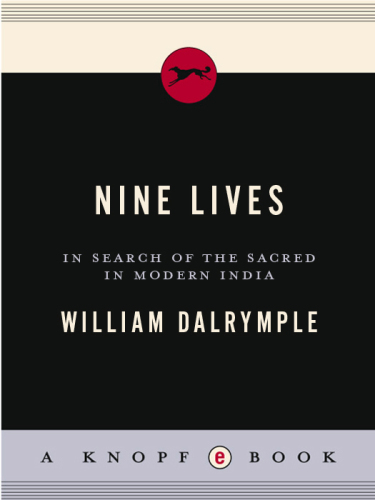
Nine Lives
In Search of the Sacred in Modern India
کتاب های مرتبط
- اطلاعات
- نقد و بررسی
- دیدگاه کاربران
نقد و بررسی

Starred review from May 17, 2010
Historian-travel writer Dalrymple (The Last Mughal) knows his Asian subcontinent, having moved to New Delhi in 1989. The engine of Indian economic development is bringing rapid change, and Dalrymple spotlights changes and constancies brought about in India’s dizzyingly diverse religious practices. The titular nine lives are those of a variety of religious adherents: a Jain nun, a sacred dancer, a Sufi mystic, a Tantric practitioner, among others. His subjects, for the most part, do their own show-and-tell in explaining their religious paths, which differ but share the passionate devotion (bhakti) that characterizes popular religion in India. Dalrymple has a good eye, a better ear, and the humility to get out of the way of his subjects. It helps to know a bit about the subject coming in, as it saves endless flipping to a very helpful appended glossary. The author also notes in his introduction he has made a special effort to avoid exoticizing “mystic India,” yet he has picked some extremes to exemplify different kinds of religious beliefs and practices. Still, those are minor quibbles about this ambitious and affectionate book that respects popular religion.

April 1, 2010
Illuminating biographies of Indians who retain ancient devotional traditions despite rapid economic change.
In a conscious reversal of the first-person method he employed in his book on Middle Eastern monks, From the Holy Mountain (1998), British journalist Dalrymple (The Last Mughal, 2006, etc.) allows these selected voices to speak for themselves—a tricky task, he writes, since the"interviews for this book took place in eight different languages." His subjects hail from diverse backgrounds. A Jainist nun lives an ascetic life in the southern pilgrimage site of Stravanabelagola. She left her family, gave away her possessions, walks everywhere so that she won't harm a living creature and now looks forward to the ultimate path toward Nirvana in sallekhana, or starving herself to death."There is no distress or cruelty," she says calmly."As nuns our lives are peaceful, and giving up the body should also be peaceful." A Tibetan Buddhist monk who lived through the persecution of the monasteries by the Chinese in the 1950s recounts his newfound attempt to achieve atonement for the violence he committed then in the name of preserving his faith. A prostitute in Saundatti, one of the legions of women consecrated in their youth by impoverished families to the service of the goddess Yellamma, describes her ghastly lot of entrenched illiteracy and almost-certain contraction of AIDS. An aged singer of 600-year-old epics performs his craft in Pabusar over five nights of dusk-to-dawn performances that function both as entertainment and devotional rite. A famous Sufi fakir at the Sehwan shrine in southern Pakistan dances a perilous line between Islam and Hinduism. Throughout the book, Dalrymple showcases his knowledge of the breadth of India and his fearless willingness to penetrate its sometimes unsavory nooks and crannies, rendering this a truly heartfelt work for readers craving a deeper connection to India and its rich spiritual heritage.
A remarkable feat of journalism.
(COPYRIGHT (2010) KIRKUS REVIEWS/NIELSEN BUSINESS MEDIA, INC. ALL RIGHTS RESERVED.)

Starred review from May 15, 2010
For the last 20 years, Scotsman Dalrymple ("The Last Mughals") has made the Indian subcontinent his bailiwick. In his introduction here, he describes "Nine Lives" as "a collection of non-fiction short stories," and he does portray the "pluralist religious and philosophic folk traditions" found in India in a way that is compelling and accessible to all readers. His subjects here are all people living on the margins: we meet a wandering Jain nun, a Tantric housewife whose abode is the cremation ground, a Sufi holy woman, a refugee from two countries, a blind Baul minstrel, and a Rajasthani bard who can recite from memory an epic of 626 pages, to name only a few. Dalrymple shows us the "lived experience" of the practitioners of these different religious paths and how their worlds have been impacted in a rapidly changing India. VERDICT More accessible but less scholarly than Wendy Doniger's "The Hindus", Dalrymple's book is highly recommended for all collections. Readers will sense the power of faith underlying the divergent religious paths, with stories that are enthralling and will keep them up late reading.Ravi Shenoy, Naperville P.L., IL
Copyright 2010 Library Journal, LLC Used with permission.

June 1, 2010
Dalrymple, author of prizewinning works of far-roaming inquiry, including The Last Mughal (2007), knows when to let others speak. Which is what he does with great finesse in this evocative set of portraits of nine spiritual seekers living across India. Nine lives that open doors onto nine of Indias many arduous paths to the divine and reveal striking, nearly surreal juxtapositions between the old and the new. Theres the haunting tale of a Jain nun who as a girl renounced her life of privilege and the wrenching story of Rani Bai, a devadasi, or servant of the goddess Yellamma, who was forced into prostitution as a girl. Hari Das describes what it feels like to be taken over by a god when he performs theyyam, the sacred possession dance of Kerala, only to return to his dangerous work as a prison guard. Dalrymple sets each vivid profile within an intricately drawn history of the ancient and now-endangered tradition each devotee is dedicated to preserving in the escalating battle between holiness and hustle that is transforming India.(Reprinted with permission of Booklist, copyright 2010, American Library Association.)

























دیدگاه کاربران